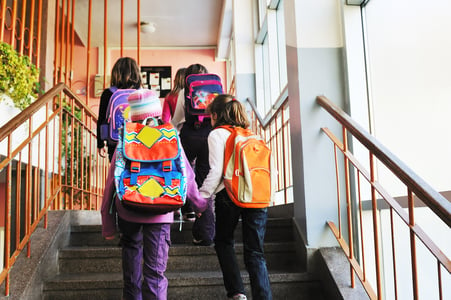
The first day a young child spends away from home, whether it's at a preschool, a home daycare, or another child care setting, can be as exciting as challenging. The two environments not only look different but feel different too.
To best support the transition, families and caregivers can work together to build consistency across the environments. One way to help the environments feel more similar is to build consistency of interactions. These interactions can not only support a child's development and learning but can begin to foster a sense of belonging, safety, and comfort.
The CLASS® tool helps to provide clear definitions of interactions that are proven to have the power to transform a child's learning experiences. Using CLASS principles as a guide, families and teachers can begin to create a meaningful bridge between the environments through consistent and quality interactions.
How To Ease the Home-to-School Transition
1. Focus on building a positive climate.
One of the easiest ways to build consistency between different environments is not by making them look alike, but also by making them feel similar. Each environment, home or school, should feel like a warm, safe place to the child. This means they feel valued and have opportunities to engage in their own interests.
In learning environments, a caregiver can talk with children at their eye level, engage in conversation about their interests, and include items in the environment that reflect the individual child. For example, giving each child their own individual space, such as a basket, or a cubby, and having it labeled with their name can make them feel more secure.
At home, families can also mirror these strategies. Speaking with the child at eye level, engaging in conversation at the dinner table, and extending opportunities for learning into the home. For example, if in school or care that day, a child learned a new song, try integrating that song into daily routines at home.
2. Create a routine.
A consistent routine can help children build their self-regulation skills, manage expectations, and promote positive behaviors. And, having a consistent routine at home and at school helps to increase a child's comfort level and confidence in knowing what to expect and what is expected of them.
In a learning environment, a caregiver can create a consistent schedule, with clear routines and expectations. And, to strengthen this strategy, children can be engaged in helping to establish the expectations! This clear routine not only can help to maximize learning opportunities but gives children ownership of their experiences within that routine.
At home, a consistent routine can also help ease the transition between home and school. Creating a consistent morning routine is a great way to signal when it is time to leave home and go to school or daycare.
Extend Quality Interactions Beyond the Classroom
Engaging families in their child's learning is often a top priority of most early childhood programs. However planning engaging opportunities for learning, collaborating, and celebrating together often proves to be difficult. Teachstone is proud to offer a new solution that makes hosting an effective family engagement workshop easier than ever.
Meaningful Interactions at Home creates a bridge between a child’s classroom and home that allows for consistency of quality interactions that promote development and learning.
